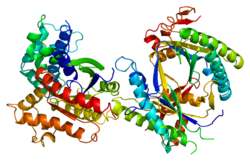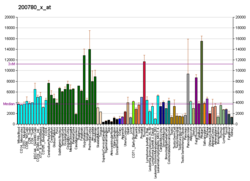Gs alpha subunit
 From Wikipedia the free encyclopedia
From Wikipedia the free encyclopedia
The Gs alpha subunit (Gαs, Gsα) is a subunit of the heterotrimeric G protein Gs that stimulates the cAMP-dependent pathway by activating adenylyl cyclase. Gsα is a GTPase that functions as a cellular signaling protein. Gsα is the founding member of one of the four families of heterotrimeric G proteins, defined by the alpha subunits they contain: the Gαs family, Gαi/Gαo family, Gαq family, and Gα12/Gα13 family.[5] The Gs-family has only two members: the other member is Golf, named for its predominant expression in the olfactory system. In humans, Gsα is encoded by the GNAS complex locus, while Golfα is encoded by the GNAL gene.
Function
[edit]The general function of Gs is to activate intracellular signaling pathways in response to activation of cell surface G protein-coupled receptors (GPCRs). GPCRs function as part of a three-component system of receptor-transducer-effector.[6][7] The transducer in this system is a heterotrimeric G protein, composed of three subunits: a Gα protein such as Gsα, and a complex of two tightly linked proteins called Gβ and Gγ in a Gβγ complex.[6][7] When not stimulated by a receptor, Gα is bound to GDP and to Gβγ to form the inactive G protein trimer.[6][7] When the receptor binds an activating ligand outside the cell (such as a hormone or neurotransmitter), the activated receptor acts as a guanine nucleotide exchange factor to promote GDP release from and GTP binding to Gα, which drives dissociation of GTP-bound Gα from Gβγ.[6][7] In particular, GTP-bound, activated Gsα binds to adenylyl cyclase to produce the second messenger cAMP, which in turn activates the cAMP-dependent protein kinase (also called Protein Kinase A or PKA).[6][7] Cellular effects of Gsα acting through PKA are described here.
Although each GTP-bound Gsα can activate only one adenylyl cyclase enzyme, amplification of the signal occurs because one receptor can activate multiple copies of Gs while that receptor remains bound to its activating agonist, and each Gsα-bound adenylyl cyclase enzyme can generate substantial cAMP to activate many copies of PKA.[8]
Receptors
[edit]The G protein-coupled receptors that couple to the Gs family proteins include:
- 5-HT4, 5-HT6 and 5-HT7 serotonergic receptors
- Adenosine receptor types A2a and A2b
- Adrenocorticotropic hormone receptor (a.k.a. MC2R)
- Arginine vasopressin receptor 2
- β-adrenergic receptors types β1, β2 and β3
- Calcitonin receptor
- Calcitonin gene-related peptide receptor
- Corticotropin-releasing hormone receptor
- Dopamine D1 and D5 receptors
- Follicle-stimulating hormone receptor
- Gastric inhibitory polypeptide receptor
- Glucagon receptor
- Growth-hormone-releasing hormone receptor
- Histamine H2 receptor
- Luteinizing hormone/choriogonadotropin receptor
- Melanocortin receptor: MC1R, MC2R (a.k.a. ACTH receptor), MC3R, MC4R, MC5R
- Olfactory receptors, through Golf in the olfactory neurons
- Parathyroid hormone receptors PTH1R and PTH2R
- Prostaglandin receptor types D2 and I2
- Secretin receptor
- Thyrotropin receptor
- Trace amine-associated receptor 1
- Vasopressin receptor 2
See also
[edit]- Second messenger system
- G protein-coupled receptor
- Heterotrimeric G protein
- Adenylyl cyclase
- Protein kinase A
- Gi alpha subunit
- Gq alpha subunit
- G12/G13 alpha subunits
References
[edit]- ^ a b c GRCh38: Ensembl release 89: ENSG00000087460 – Ensembl, May 2017
- ^ a b c GRCm38: Ensembl release 89: ENSMUSG00000027523 – Ensembl, May 2017
- ^ "Human PubMed Reference:". National Center for Biotechnology Information, U.S. National Library of Medicine.
- ^ "Mouse PubMed Reference:". National Center for Biotechnology Information, U.S. National Library of Medicine.
- ^ Ellis C, Nature Reviews Drug Discovery GPCR Questionnaire Participants (July 2004). "The state of GPCR research in 2004". Nature Reviews. Drug Discovery. 3 (7): 575, 577–626. doi:10.1038/nrd1458. PMID 15272499. S2CID 33620092.
- ^ a b c d e Gilman AG (1987). "G proteins: transducers of receptor-generated signals". Annual Review of Biochemistry. 56: 615–649. doi:10.1146/annurev.bi.56.070187.003151. PMID 3113327. S2CID 33992382.
- ^ a b c d e Rodbell M (1995). "Nobel Lecture: Signal transduction: Evolution of an idea". Bioscience Reports. 15 (3): 117–133. doi:10.1007/bf01207453. PMC 1519115. PMID 7579038. S2CID 11025853.
- ^ Purves D, Augustine GJ, Fitzpatrick D, Hall WC, LaMantia AS, White LE, eds. (2007). Neuroscience (4th ed.). New York: W. H. Freeman. p. 155. ISBN 978-0-87893-697-7.
External links
[edit]- G(s)alpha at the U.S. National Library of Medicine Medical Subject Headings (MeSH)
- GNAS+protein,+human at the U.S. National Library of Medicine Medical Subject Headings (MeSH)
- Overview of all the structural information available in the PDB for UniProt: P63092 (Guanine nucleotide-binding protein G(s) subunit alpha isoforms short) at the PDBe-KB.







